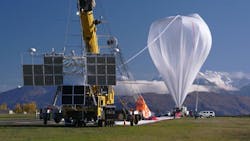Army approaches industry about surveillance sensor payloads for use aboard high-altitude balloon systems
ABERDEEN PROVING GROUND, Md. – U.S. Army experts are asking industry for suggestions on small, lightweight radar and radio reconnaissance technologies appropriate for surveillance balloons operating at altitudes of 60,000 feet or higher.
Officials of the Army Contracting Command at Aberdeen Proving Ground, Md., issued a request for information (W56KGY-24-R001) for the Multi-Domain Sensing System High-Altitude Platform – Deep Sensing (HAP-DS) project.
These balloon-based sensor payloads are to support large-scale ground combat operations, and fill sensing gaps for indicators and warnings, long-range precision fire targeting, and situational understanding. The Army Contracting Command is issuing this information request on behalf of the Army's Project Director Sensors And Aerial Intelligence.
The Army wants information on small-form-factor electronic intelligence (ELINT), communications intelligence (COMINT), and radar sensor technologies for high-altitude balloons.
These COMINT, ELINT, and radar sensor payloads should weigh less than 15 pounds, and use power and communication equipment already on the high-altitude balloon.
The HAP-DS project is closely related to the Army's High-Altitude Extended-Range Long-Endurance Intelligence Observation System (HELIOS) program, and will host demonstrations and experiments for HELIOS.
Army experts want to know the technology state of the art in small, lightweight COMINT, ELINT, and radar sensor payloads; sensor capability maturity; and industry capabilities to carry out either an anechoic and barometric chamber test or flight test of these enabling technologies.
The Army wants to learn about today's off-the-shelf ELINT, COMINT, and radar solutions that are ready for operational prototypes that meet the guidelines of the Sensor Open Systems Architecture (SOSA) and Modular Open System Approach (MOSA) approaches to standardized mounting, power, connections, software, electronic interfaces, heating, ventilation, and cooling for altitudes higher than 60,000 feet.
From industry, the Army is asking for white papers that provide information on high-altitude sensor performance and capabilities, as well as an assessment of technology and integration readiness of today's ELINT, COMINT, radar, or multi-capability sensor hardware.
White papers also should provide cost estimates, manufacturing capabilities, whether prototype sensor payloads could be demonstrated at Aberdeen Proving Ground sometime before September 2025.
Companies interested should email seven-page white papers no later than 22 July 2024 to the Army's Stephanie Lawrence at [email protected]; Jacqueline Bailey at [email protected]; and Abram Sedhom at [email protected]. More information is online at https://sam.gov/opp/26c52600b710476f9dad31599fc9a30f/view.
About the Author
John Keller
Editor-in-Chief
John Keller is the Editor-in-Chief, Military & Aerospace Electronics Magazine--provides extensive coverage and analysis of enabling electronics and optoelectronic technologies in military, space and commercial aviation applications. John has been a member of the Military & Aerospace Electronics staff since 1989 and chief editor since 1995.
